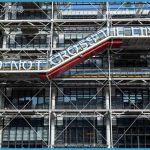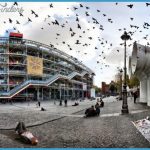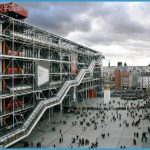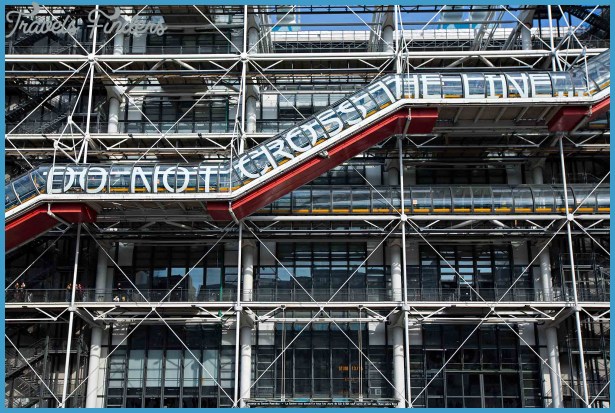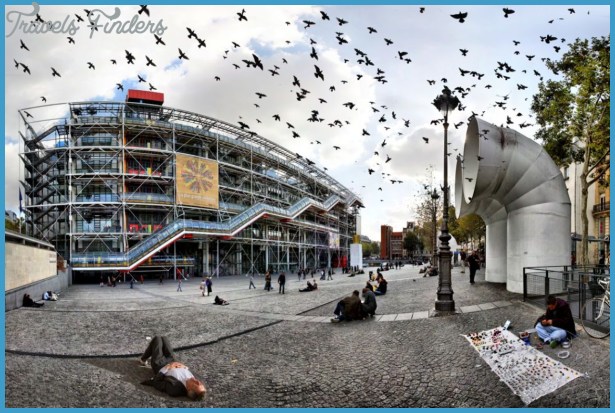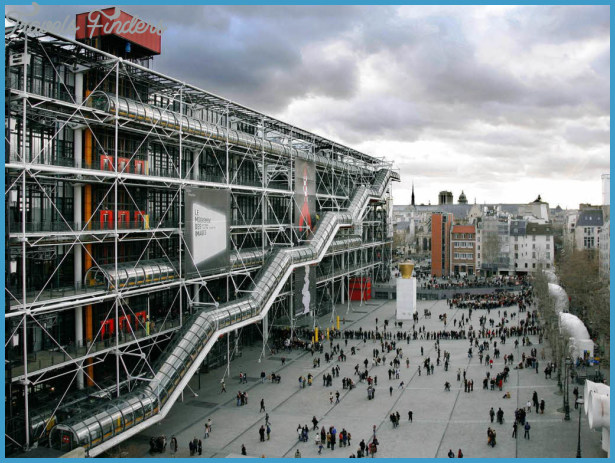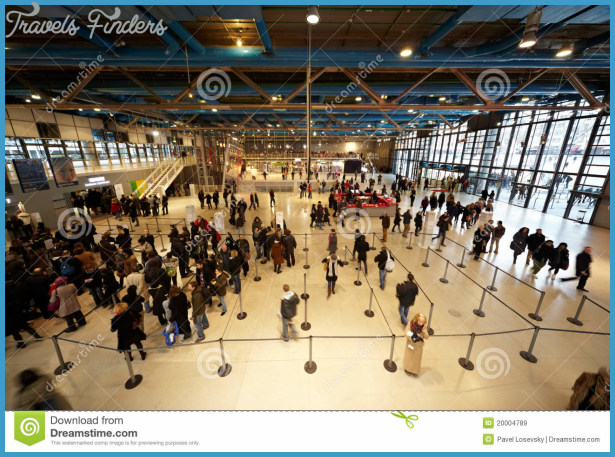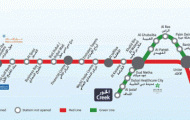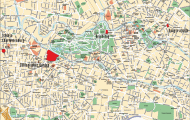RICHARD ROGERS AND RENZO PIANO
Located right in the heart of Paris, the Pompidou Centre houses the Musee National d’Art Moderne-one of the largest modern art collections in the world-and an extensive public library, and hosts a wide range of cultural activities. To create the maximum amount of interior space, Richard Rogers and Renzo Piano designed a radical, high-tech structure in which all the services, from the water pipes to the escalators, were suspended on the exterior of the building, leaving the floors and walls inside uncluttered.
Visually, the result of the architects’ decision to turn the building inside-out is dramatic. The Pompidou Centre does not have the grand, immaculately finished facades usually found on major galleries but looks more like a giant machine or factory on which an outer structural grid of steel uprights, horizontals, and diagonals is liberally festooned with colorful ducts, tubes, and containers. The rear facade of the building displays a diverse collection of these services, while on the front, which is clad in a less cluttered steel grid, an escalator enclosed in a glazed tube rises in stages, giving visitors views of the bustling piazza below.
The impact of this design approach is, however, more than just visual. By putting the services on display like this, the architects were able to design them too, and they worked closely with the engineers to ensure that everything worked efficiently. The interior of the building is much simpler in comparison, with large windows overlooking both the surrounding streets and the city beyond. The galleries have expansive areas of uninterrupted floor space, including large, flexible spaces that can be reconfigured to suit the specific demands of each exhibition. The network of brightly colored ducts continues across the ceilings, creating a strong visual link with the exterior. A favorite destination for visitors to Paris, the Pompidou Centre is a vibrant space both inside and out.
RICHARD ROGERS b. 1933
The Italian-born architect studied in London and at Yale, where he met Norman Foster. Initially, Foster, Rogers, and their wives, Su Brumwell and Wendy Cheeseman, practiced as Team 4, designing high-tech structures.
In 1967 Rogers left the practice to work with Italian architect Renzo Piano, and together they created the Pompidou Centre, which brought both of them international fame. Rogers has subsequently worked all over the world on many high-profile buildings, from the European Court of Human Rights in Strasbourg, to part of the reconstructed World Trade Center site in New York. His current practice, Rogers Stirk Harbour + Partners, has been involved in several landmark projects, including Madrid’s Barajas Airport and the Bordeaux Law Courts. A Pritzker Prize winner, Rogers has written widely on urbanism and has also been influential in European city planning.
Visual tour
1 EXTERIOR DUCTS The rear wall has the largest collection of service ducts, which run both inside and outside the steel framework of the building. These were color-coded: plumbing was green; the ducts and tubes of the climate-control system were blue; electrical installations were yellow; and the parts of the building used for circulation were red. Although some of the original colors have been modified, the twisting forms of the ducts and pipes still create a vivid splash of color on the building’s urban site.
Horizontal metal beams run the entire width of the building
Vertical steel columns support beams and services
A glass “skin” inside the framework covers most of the building
1 EXTERNAL FRAMEWORK Steel columns run all the way up the building, supporting a network of horizontal beams and diagonal struts, some with integrated emergency stairs. The whole system looks as simple as scaffolding, but the structural demands on the framework are much greater. The project’s large team of skilled engineers was crucial to its success.
1 ESCALATOR TUBE One of the Pompidou Centre’s most distinctive features is a long, glazed tube that projects dramatically from the steel framework of the main fagade. The tube encases escalators that snake their way slowly up the building, stopping at the different floors. The red cladding of the rising portions of the tube is just visible at the bottom of each escalator.
4 INTERIOR SPACE
The high and spacious exhibition areas are flooded with natural light from the large windows along the fagades. As on the outside, much of the structure is exposed. The white horizontal beams joined by diagonals on the ceilings are the main structural beams that tie the building together, support the floor above, and penetrate the glass wall to join the upright columns outside. The network of blue ducts is part of the building’s climate-control system.
IN CONTEXT
The high-tech approach adopted by Rogers and Piano for the Pompidou Centre was developed in the 1970s by a number of architects notably Rogers and Norman Foster, who were interested in technology, materials, and structure and wanted to display these aspects of design openly. As a result, high-tech buildings usually have exposed structures generally lightweight and made using steel frames, which are sometimes chosen because they are adaptable and easy to assemble. The other key aspect of high-tech architecture is the finish of the exterior, as seen on the Lloyd’s Building designed by Rogers, which is typically smooth and immaculate glass and polished steel are favorite materials.
1 Lloyd’s Building, London, UK, 1978-84
2 STRUCTURAL FRAMEWORK One of the challenges for the engineers was to find a way of hanging the structural elements from the upright columns. They used a design called a gerberette, which consists of a short horizontal casting that swells in the middle where it is joined to the column. Attached to the right-hand end of the gerberette is one of the main structural beams that support the building’s roofs and floors; to the left of it are the beams and rods that carry the escalator.
1 INTERIOR OF TUBE Visitors using the escalators travel through tubes glazed with clear acrylic sheets. Unlike interior escalators and elevators, this arrangement offers an interesting visual experience. To one side the building can be seen in close-up; on the other there are views across the neighboring squares and streets. Higher up, the rooftops and church spires of Paris are visible far into the distance. The tubes themselves enhance the building by reflecting the changing colors of the sky.

